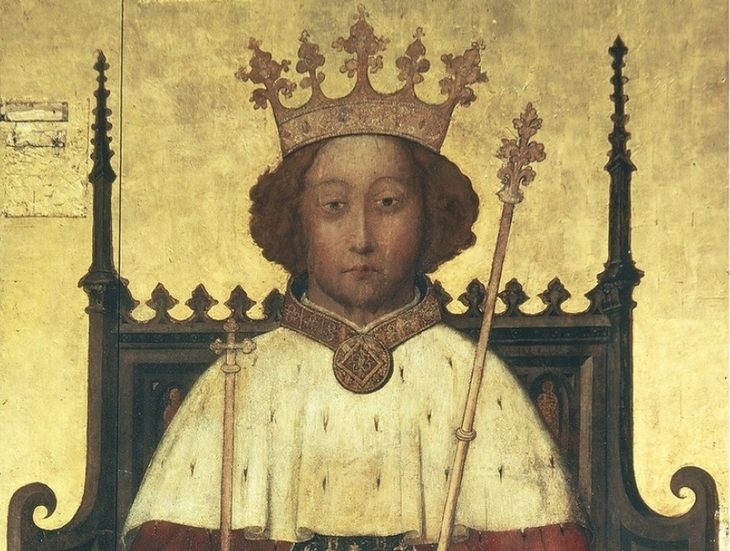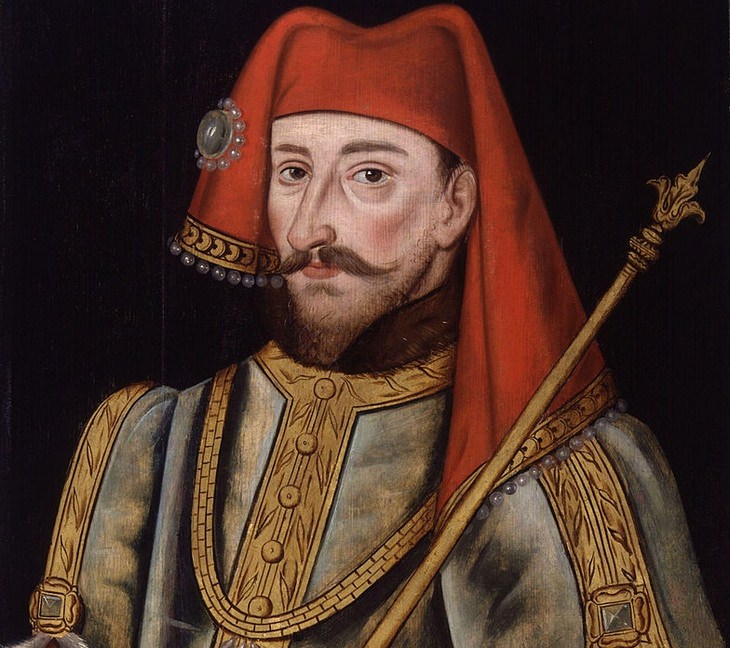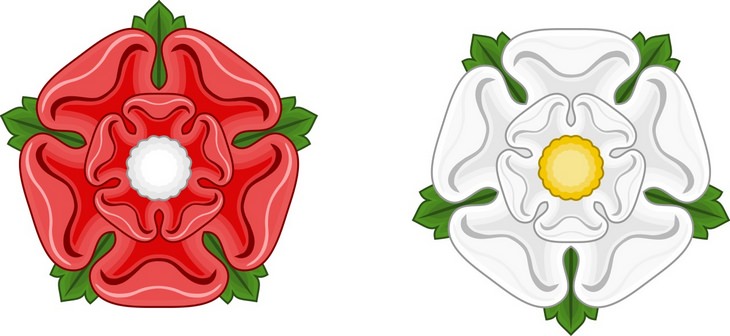
Richard II of England
In 1376-77, both Edward III of England and his heir, the Black Prince died, leaving only Richard, the 10-year-old Black Prince’s son to rule. The country was steeped in debt owing to the expensive war in France and a council was established to help the boy king govern during his minority, with his uncle John of Gaunt, Duke of Lancaster serving as one of the king’s closest advisors.
Early into his reign, peasant revolts ravaged the countryside, and with most of the king’s army preoccupied in military engagements abroad, there was very little the crown could do. The rebels wanted an end to serfdom in England and to reduce the taxes imposed on the peasantry, and so they marched on London, wreaking havoc in their wake, destroying crown properties, releasing prisoners and murdering officials.
To begin with, the king and his advisors surrendered to the rebels’ demands, but the ringleaders were still dissatisfied and a second parley was arranged. During the meeting, the chief leader of the revolt was killed in a brawl with the king’s men and the peasants were ready to riot, when the 14-year-old king did something completely unexpected: he rode towards the masses alone and addressed them, saying that he will be their chief and captain and that he shall provide for them. Without a leader and mesmerized by Richard’s charisma, the crowd dispersed.

Richard II meeting with the ringleader of the Peasants' Revolt and the brawl that followed
While this may sound like the beginning of a positive reign, what Richard took away from this experience was that promises made to the common folk mean nothing and can be reneged upon with impunity and that he doesn’t need the council in order to rule, as that was his divine right and God-given talent. Richard II became progressively more obsessed with the trappings of power and pushed the established nobles out of his circle of confidantes, replacing them with personal favorites.
In 1387, the frustrated nobles, including one of Richard’s royal uncles, Thomas of Woodstock and his cousin by John of Gaunt, Henry Bolingbroke, accused the king’s favorites of treason and undue influence on Richard, and so they raised an army and led a successful revolt which saw Richard’s compatriots either executed or flee England. The king never forgave the rebellious lords, and ten years later he had three of the chief conspirators, including his uncle, imprisoned or executed.

The rebellious lords before king Richard. Henry Bolingbroke is the second man from the right
While his relationship with his other uncle, John of Gaunt, remained close, Gaunt’s son Henry did not escape Richard’s vengeance, and when Henry Bolingbroke came to Richard with accusation against another one of the erstwhile rebels, Thomas de Mowbray, that the latter was speaking treason against the king, Richard opted to exile both nobles. To add insult to injury, when John of Gaunt died a few years later, Richard confiscated all of Bolingbroke’s inheritance.
This did not sit well with Henry, who returned to England and raised an army while Richard was fighting in Ireland. Originally, it was Bolingbroke’s intent to only demand his lands back, but by the time of his invasion, the people and nobles were so sick of Richard II and his abuses of power that Henry was able to depose Richard and imprison him in the Tower of London, where Richard was assassinated, much like what had happened to their uncle Thomas of Woodstock a mere two years ago, upon Richard’s order.

Henry IV of England
Henry Bolingbroke became Henry IV of England, and herein lies the thorn that would give rise to the War of the Roses: Henry was not the first in line to the throne. John of Gaunt was Edward III’s third surviving son, with his second son, Lionel of Antwerp, dying a full decade before Richard rose to the throne. And while Lionel had no sons, he did have a grandson by his daughter, Edmund of Mortimer. According to the English laws of succession, the crown should have gone to Edmund, but be it because Mortimer was only seven at the time and England had enough of boy kings after Richard, or because of a preference for a patrilineal heir, Edmund Mortimer was overlooked.

The sigils of both branches of the royal family, red rose for Lancaster, white rose for York. Source:
SodacanDuring the reign of Henry IV, a major rebellion erupted with the intent of placing Mortimer on the throne, but the rebellion was narrowly foiled and the child heir was uninvolved in the plot. On the contrary, Edmund Mortimer appeared only too happy to be a loyal vassal to his kinsmen, and when in 1412 his sister’s husband Richard, a grandson of Edward III himself through his father the Duke of York (Edward III’s fourth son), hatched a plot to depose Bolingbroke’s son, Henry V, it was Mortimer who told the king. The Yorkist Richard was executed, but that wasn’t the end of it. It was only the beginning, as Richard had a son, descended from both Lionel of Antwerp and the Duke of York, who had just as good a claim for the throne as the king.
But that story, of how the War of the Roses began in earnest, pinning cousin against cousin, will have to be told on another day...
Related Articles:

 Richard II of England
Richard II of England Richard II meeting with the ringleader of the Peasants' Revolt and the brawl that followed
Richard II meeting with the ringleader of the Peasants' Revolt and the brawl that followed The rebellious lords before king Richard. Henry Bolingbroke is the second man from the right
The rebellious lords before king Richard. Henry Bolingbroke is the second man from the right Henry IV of England
Henry IV of England The sigils of both branches of the royal family, red rose for Lancaster, white rose for York. Source: Sodacan
The sigils of both branches of the royal family, red rose for Lancaster, white rose for York. Source: Sodacan